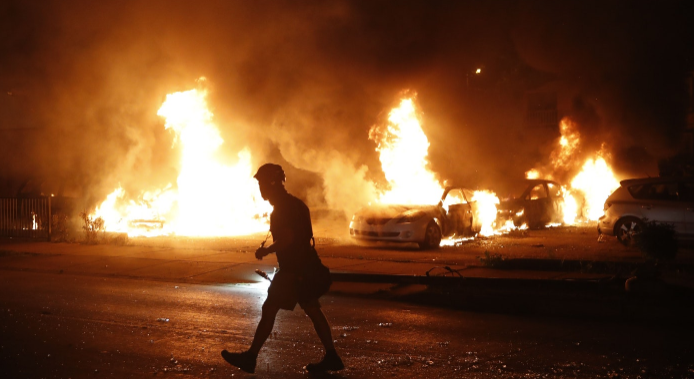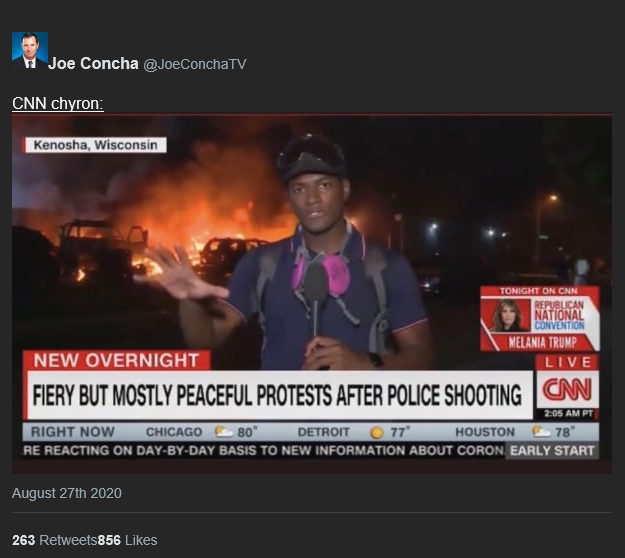Victor Davis Hanson, January 31, 2022 - Blade of Perseus
American Greatness
Chaos is the new, the intentional, normal. A pandemic of nihilism has been unleashed upon the land. As in Lord of the Flies, when laws, rules, protocols, traditions, and customs are mocked and dismantled, primitive human nature in the raw is unleashed.
Madness now reigns in every quarter, from the iconic to the irrelevant to the fundamental. Statues of Lincoln, Douglass, and Jefferson are toppled or defaced. The rules of capitalization have been altered. We are told that 1619, not 1776, was our founding date—and this by a “civil rights” activist-journalist who had no idea of the date that the Civil War began.
Quite quickly after the revolutionary boilerplate, America began reverting to its natural Hobbesian or Thucydidean essence. If you dispute that, look at looted packages along the Union Pacific tracks in Los Angeles. Try walking the nocturnal streets of Chicago or Baltimore. Visit the sidewalk homeless of San Francisco. Fly over our constipated ports. Drive into our empty new car dealerships. Pull up to our European-priced gas pumps. Shop in the emptying shelves of our Sovietizing food and discount stores. The common theme of the upcoming Super Bowl halftime show, apparently, is that the entertainers must have written lyrics threatening the police, denigrating women, using the N-word . . . and be worth $100 million.
Of course, that is what the elites celebrate, as people struggle to buy food, gas, and cars. The police are under attack and being killed on the street. The public is bewildered about criminals not being punished, workers paid to stay home, and biological men commandeering women’s sports.
Abnormal is normal; normal is despised and discarded.
Friends and associates of all races and ethnicities are increasingly suspicious of each other. They are fleeing to the ancient refuge of tribal solidarity. Red states are hated, although they function, and are sought out; blue states are praised, even as they fail and residents flee. Our “leaders” are doing their best to confirm the age-old invective of our enemies that e pluribus unum simply cannot work.
Americans keep being pounded with “Vaccination! Vaccination! Vaccination!”—but never with commensurate advice on therapies, affordable drugs, and pragmatic protocols to survive COVID-19, as it often breaks through to the already thrice vaccinated.
Americans could tolerate the misinformation and the contradictions emanating from the CDC, the NIH, and NIAID. But only if the deceptions were issued with some humility and qualifiers, reminding us of our shared ignorance about the mysterious virus. Instead, pompous and insufferably sanctimonious bureaucrats sent out flurries of false knowledge, as if they were religious edicts, with implied medieval punishments for the apostates. Apologies never follow.
The public cannot fathom the border. Prior presidents hunting for cheap political gain (Republicans for more labor, Democrats for new constituents) were lax on immigration enforcement. Yet no president has ever deliberately invited in more than 2 million foreign nationals—entering illegally, impoverished, unvaccinated, untested, and without background checks. No prior president has not only violated his oath of office to enforce the laws of the United States, but simply and intentionally destroyed the law as it was written. Apply the Left’s 2019-2020 impeachment standard to Joe Biden’s first year, and he would be impeached the minute a Republican majority captured the House.
Americans sense the United States is losing all influence abroad, as allies gravitate to or appease China and Russia. The public does not lament the loss of global clout and prestige alone. Rather, the people also fear the end of the ancient American strategy of keeping foreign enemies far distant from the homeland.
As they figure out the themes of the present madness, Americans become troubled as they attempt to fathom the characteristics of the ongoing nihilism.
One, they see much of the sudden anarchy as self-induced, deliberate, agenda-driven, and as correctible as it was avoidable. In other words, the catastrophe of 2021 was no accident, but a tactic in service of a strategy.
Two, they conclude that the nihilism intentionally targets the despised middle class—those who tend to obey the rules, who pay their taxes, who don’t get arrested, who largely keep quiet—and who are standing in the way of a revolution. These Americans are underrepresented in crime, in upward mobility, and on most college campuses, but overrepresented in suicide rates and the death tolls in optional wars abroad.
For their part, the hoi polloi conclude that the more that they are libeled as “victimizers,” the more they are becoming the actual victims. Indeed, the heroic “victimized” are the ones most often flouting the law, committing violent crimes, and tearing down the institutions that in bygone days provided security and prosperity for everyone.
Three, ordinary citizens feel the law has utterly vanished. Sometimes it simply is ignored, as we see with revolving-door criminals who kill, maim, and loot with near impunity. Sometimes the law simply is asymmetrically applied. The administration correctly jails those convicted of illegally entering the Capitol and trashing the chambers of government, but it then grants de facto amnesties to the thousands who deliberately injured, torched, and looted for 120 days of riots, death, and mayhem in 2020.
Joe Biden meanders through his photo-ops indifferent to American civilization collapsing around him. His first year was the most disastrous of any presidency in history. Should that calamity continue, Biden will be known by posterity as the most inept president to have held office.
So why does he not take to the bully pulpit to deplore the current smash-and-grab, carjacking, and murder epidemic now reaching either all-time highs or levels not seen since the 1970s? Does Biden have a shred of empathy for the widow of a murdered policeman, the spouses and parents of those mowed down in Waukesha, the children shot dead in Chicago?
Joe Biden defended his policies by saying that automobile price spikes account for one-third of the spiraling consumer price index. So what? Does that mean inflation is somehow tolerable—as if citizens don’t drive cars most days of their lives?
Is Biden aware that his administration’s core inflation definition and the consumer price index itself exclude energy as well as food price increases? What the real inflation rate is no one knows—but all understand that what we see and feel every day is far worse than what we are told.
Biden has never explained to us the humiliation in Afghanistan—other than to whine that the generals failed to warn him of his own folly. Does he know why now Vladimir Putin again ponders attacking his neighbors—but did not between 2017 and 2020?
Did Biden ever consider the fast-tracking of pipelines, more fracking, a restoration of 2020 levels of oil and gas production, and more leases granted to avoid America’s continued dependence on the Russians and the Middle East? Instead, Biden begged Russia and the Saudis—both of whom he has derided—to pump more of the oil he despises, and which we have in abundance but will not use.
Did Biden once say stop the new racial tensions, or argue that Americans should worry first about the content of our character not the color of our skins? Has he ever worried about the racial cauldron he has lit and fueled? Not at all.
Instead, Biden has done his best to inflame race through his own vile racist slurs. The recent “you ain’t black,” “junkie,” “boy, “negro,” are added to his prior inflammatory repertoire of “clean African-American,” “put y’all back in chains,” and the racist Corn Pop saga.
Second, Biden demagogues race to win the support of his base of racialists. Has any president ever announced ahead of time that only those of a particular race and gender would be eligible for selection as his running mate and first Supreme Court nomination? At least Harvard keeps quiet about its racialism and does not flaunt the idea that it systematically discriminates against Asians.
So, in a vast multiracial democracy of tribal competition and tensions, Biden has done his best to turn Americans against each other—and has succeeded in a fashion that would have made his old Dixiecrat Senate mentors Robert Byrd and James O. Eastland proud.
The mystery is perhaps not that nihilism has swept through America as effectively as Omicron, but why the president and the Left unleashed it. So, what explains the madness?
First, Biden is cognitively challenged to the point of not being physically or mentally able to meet the challenges of the presidency. His handlers know it. The media knows it. And the public knows it, too.
Irony has become the Left’s enemy. After screaming that Donald Trump should be removed under the 25th Amendment, that he should take a mental competency test, and that everyone from the acting director of the FBI to Ivy League psychiatrists must scheme to prove he was nuts, they all have grown silent. The Left’s quiet reflects that they are terrified that anyone else might successfully do to a genuinely enfeebled and failed president what they themselves attempted to do to a cognizant and successful president.
Biden’s assigned task in 2020 was to put a familiar “centrist” veneer on a radical agenda. Thereby, the hard Left, with the help of COVID-19 and Silicon Valley, could push that agenda past an unsuspecting public. Upon election, Biden would not revert to old Joe from Scranton deploring the leftist tool that he had become.
The movers of the agenda are the hard Left of the Democratic Party, those who circle around Bernie Sanders, the Obamas, Elizabeth Warren, and “the squad.” The shock troops are Black Lives Matter, Antifa, the millions on the campus, and the internet mob. The more confusion, chaos, and anarchy that follows, the more of their agenda they hope to push through, if not by legislative vote, then by executive edict, court decision, or simply ignoring the law.
The third catalyst of the woke chaos are the hyper-rich—the franchise owners of the Left. These are the huge donors who nourish the think tanks, the media, the PACs, and the legal teams—the Zuckerbergs, the Soroses, the Bezoses and the rest of the Silicon Valley plutocracy.
Equally important are the hypocritical professional classes—the tech upper-echelon, the media cohorts, the corporate lawyers and CEOs, the various university professoriate and administrations, the celebrities, the professional athletes, and the bicoastal movers and shakers. On the one hand, they are assuming that Americans won’t actually vote for their neosocialist utopias, which can be enacted only by changing the rules or demography or both. And on the other hand, they are hedging that their money, influence, and power will insulate them and their own from the stampede at the border, the growing criminality in the cities, price hikes that batter the middle classes, and the tribalism and racialism they helped to greenlight.
In normal times, such hard-left agendas have no resonance. But during a plague, lockdown, riots and arson, during murder and mayhem, chaos and anarchy?
- - -
You may want to visit Dr. Hanson's website that offers both public and subscription content.





 RSS Feed
RSS Feed
